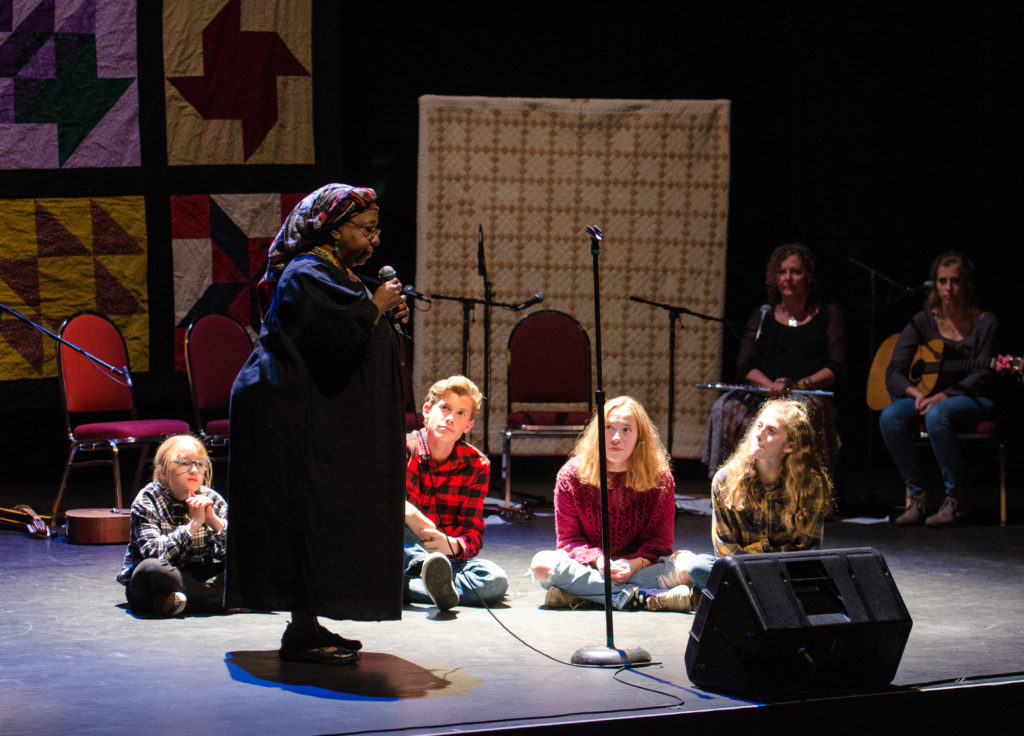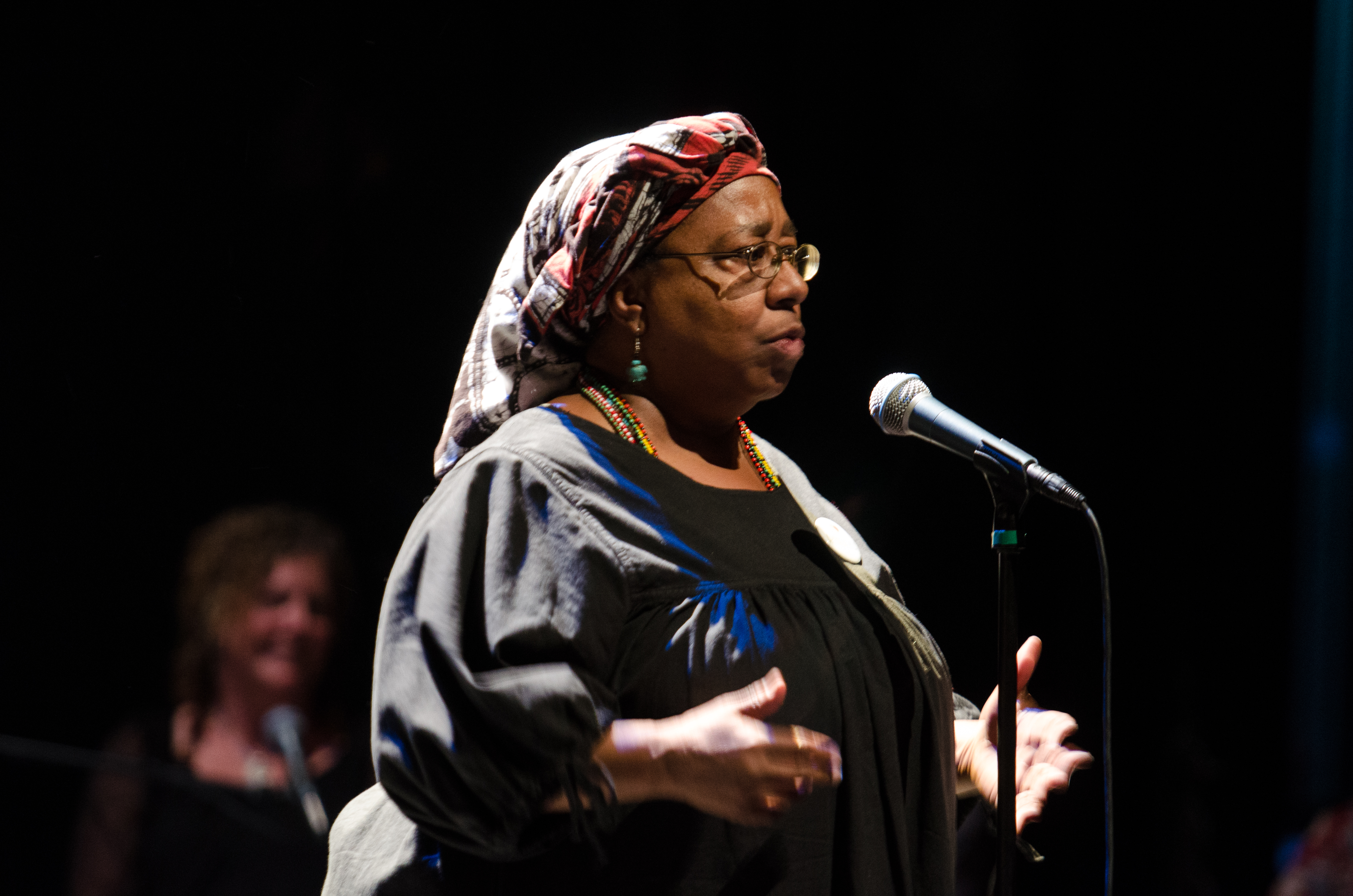As with everyone involved with the Urban Appalachian Community Coalition, the work of community engagement is a natural outgrowth of life experience and chosen endeavors. Omope Carter Daboiku is one of those people who has threaded her creative work through the fabric of UACC. From the, often hidden work of planning and implementing research and events, to stepping onto a stage to hold a performance together, Omope is a vital force within UACC. I had the pleasure of talking with Omope Carter Daboiku and to learn about her work with UACC and beyond.
Omope is from Ironton, Ohio, a small town in the Ohio Appalachian region across from Ashland, Kentucky. When I spoke to Omope she was quick to tell me that if you are from Ironton, it is pronounced Arnt’n. “We get rid of extra vowels and consonants when it becomes clear that we don’t them,” she explained. Omope can trace family lines in just about any direction and back through generations. What emerges is that her family and the people close to her were drawn to the iron works and coal mines of Ironton and the surrounding area like so many others from within the Appalachian region. Living in Ironton both cradled and isolated her family in the region in ways that are quite familiar to the Appalachian experience. It would take moving away and heading off to college to provide the context for some of the work that defines her life to this day.
Omope has played some crucial roles in the work of both the Urban Appalachian Council and UACC. One of the stand-out moments was throwing her support as Local Arrangements Chair in the monumental effort to bring the Appalachian Studies conference to Cincinnati. As Omope explained, “The Appalachian Studies Conference changed things. That event helped establish UACC as a force to be reckoned with, and we altered the way things are done in the world of Appalachian studies.” This is just one example of how Omope has impacted the work and continued presence of UACC in community engagement and in the larger conversation on Appalachia.

After leaving Ironton in 1971 to attend college at Ohio State University, Omope began the process of discovering how her unique experience as a black Appalachian woman held the promise of expanding what had become a rather narrow definition of Appalachian people. She explained that the same commission that created the Great Smokey Mountain National Park also created the image of the white mountaineer as the dominant image of what the world as come to identify as an Appalachian. She told me that an eye-opening experience was at the first Appalachian Festival where she became excited to see a map at UAC’s booth on which you could put a sticky note on your “home place” to identify your home within the Appalachian region. No one had put a sticker on Ironton, even though it was clearly in the Appalachian region. “I put my sticker on my home place, and someone said, you are a true Appalachian.” That made the connection for her—a connection that would define her relationship to her work in one way or another from that point on.
Omope explained to me, “Before I even knew about the concept of African-American, before I thought about being black, I knew from my life growing up, from my language, and from my music that I was a hillbilly.” More than anything, the culture of a small Appalachian town like Ironton defined her identity. The experiences of her work beyond the small town in Appalachia would define her work as an African American woman. Omope explained, “I had to learn to work with urban black women. I had to learn to work with people who did not think like me but looked like me.” The issue of Appalachian identity and the tensions we experience as this identity collides with other definitions of the self are a constant feature of the experiences of urban Appalachians. Yet, this tension often becomes the spice that flavors the contributions of urban Appalachians like Omope Carter Daboiku.
Omope now lives in Dayton where she works as an independent scholar-artist. She has taught mosaics with young children, led workshops with Muse Machine, which reaches over 70,000 students with their arts and education programs, and managed to submit groundbreaking work with the Association for the Study of African American Life and History. This last was on the work of Carter G. Woodson who, as Omope explained, “gave us the idea of black hillbillies.” This is just a sampling of Omope’s work. The list goes on longer than space allows.
Omope says that “living and remembering is my art.” These are features of the traditional African “Griot,” a term Omope does not take for herself, even if the title applies. My overall impression was that the art of living and remembering comes so naturally for Omope Carter Daboiku that official titles do not feel necessary. From her work with the Urban Appalachian Community Coalition to her creative presence as a storyteller, Omope has every intention of remaining active in the world of urban Appalachia. I will tell you that talking to Omope is a treat in itself. I walked away from this conversation genuinely inspired. Omope told me she persists and grows as an artist in the same she always has, as she explained, “I just kept my hands on the plow.” I would insist she has done a little more than that, but I am not interested in arguing with Omope Carter Daboiku.
Mike Templeton is a writer, independent scholar, barista, cook, guitar player, and accidental jack-of-all-trades. He lives in downtown Cincinnati with his wife who is a talented photographer. They spend their free time walking around the city snapping photos. She looks up at that the grandeur of the city, while Mike always seems to be staring at the ground.


I loved reading Omope’s history. I appreciate her storytelling. She inspires many.
Thank you for this wonderful article on Omope Carter Daboiku. Her many contributions to art, music and story telling are to be commended!